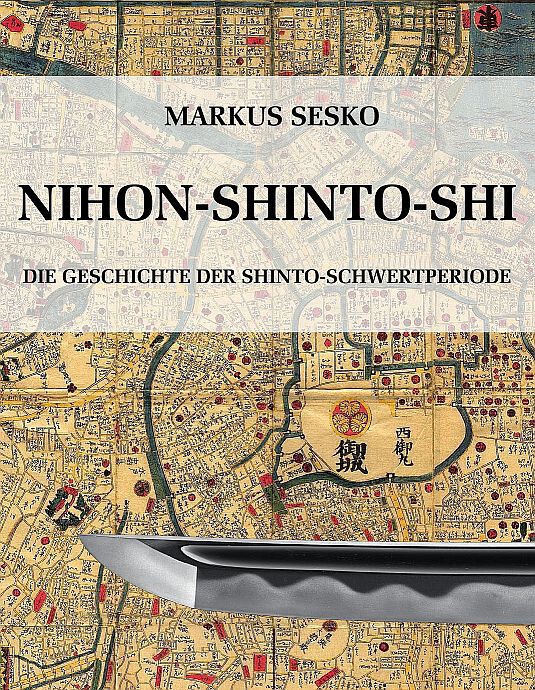-
Posts
925 -
Joined
-
Last visited
-
Days Won
23
Content Type
Profiles
Forums
Events
Store
Downloads
Gallery
Everything posted by Markus
-
John pointed out an important thing, namely the interplay between what you read and what you see. If there is a fascination and if you don´t get frustrated by setbacks (which happen to anybody), it is a kind of procedure which keeps itself alive. I wanted to say that reading, seeing hands-on what you had read about, re-read about what you just had seen and so on is the key. The only thing you must never do is to rest on your laurels and assume that it is enough for the moment and the end is in sight. There is never ever such an end :D Another tip: Have a certain blade explained when you have the chance to. We often make the mistake and think "Oh it´s ok. I just saw it. I will read about the unclear points when I am back home." This doesn´t work. I experienced that myself quite often.
-
I just want to inform those who obtained my first two Kantei volumes that there is now a first supplement volume available. It contains 61 blades as seen in the preview of the contents below. FYI: A second supplement volume will not be published before the very end of the year. It can be obtained as usual via Lulu.com: http://www.lulu.com/shop/markus-sesko/k ... 42701.html And the eBook here: http://www.lulu.com/shop/markus-sesko/e ... 42710.html And here the links for the German version: http://www.lulu.com/shop/markus-sesko/k ... 42643.html http://www.lulu.com/shop/markus-sesko/e ... 42654.html Thank you for your interest. ContentsKanteiSupp.pdf
-
@Jeremy: FYI and from my swordsmith index: Hiromasa (広正), 1st gen., Enbun (延文, 1356-1361), Sagami – „Sōshū-jū Hiromasa“ (相州住広正), „Hiromasa“ (広正), student of the 1st gen. Sōshū Hiromitsu (広光), in old sword books we find drawings of -zukuri ko-wakizashi with date signatures from the Ryakuō (暦応, 1338-1342) to the Jōji era (貞治, 1362-1368) but it seems that there are no more works extant by him today, the depicted blades show a hoso-suguha mixed with ko-midare or an hitatsura Hiromasa (広正), 2nd gen., Eiwa (永和, 1375-1379), Sagami – „Sōshū-jū Hiromasa“ (相州住広正), „Sagami no Kuni-jū Hiromasa“ (相模国住広正), first name „Kurō“ (九郎), according to transmission the son of Sōshū Masahiro (正広) and a student of Hiromitsu (広光), ō-gunome, suguha, gunome-midare mixed with togariba, wazamono Hiromasa (広正), 3rd gen., Ōei (応永, 1394-1428), Sagami – „Sōshū-jū Hiromasa“ (相州住広正), „Hiromasa“ (広正), it is said that he also signed with the name „Hiromitsu“ (広光), midare, hitatsura, gunome-midare or suguha Hiromasa (広正), 4th gen., Bun´an (文安, 1444-1449), Sagami – „Sōshū-jū Hiromasa“ (相州住広正), „Hiromasa“ (広正), gunome-midare, suguha or hitatsura in ko-nie-deki, many blades bear horimono, there are relative many works extant from the 4th gen. Hiromasa onwards, we know blades from the Bun´an to the Kanshō era (寛正, 1460-1466), jōjō-saku Hiromasa (広正), 5th gen., Meiō (明応, 1492-1501), Sagami – „Sōshū-jū Hiromasa“ (相州住広正), „Hiromasa“ (広正), gunome-midare or hitatsura in nioi-deki with ko-nie, we know detailed and elaborate horimono, he was active around Bunmei (文明, 1469-1487) to Eishō (永正, 1504-1521), jōjō-saku Hiromasa (広正), 6th gen., Tenbun (天文, 1532-1555), Sagami – „Sōshū-jū Hiromasa“ (相州住広正), „Hiromasa“ (広正), he also worked in Ise province
-
Something similar is just discussed on facebook: So they don´t allow Magnolia wood and products out of the country?
-

two character mei second character is mitsu first ?
Markus replied to b.hennick's topic in Translation Assistance
Haha, thank you Brian. But it was more my belly speaking than my brain and without any further pictures, I would not bet on "katsu". -

two character mei second character is mitsu first ?
Markus replied to b.hennick's topic in Translation Assistance
I think I can see some traces of a (月) radical to the left. This gut feel is also supported by the slight shift of the legible part to the right. Also the lower radical seems to be (力) and the uppermost vertical stroke is not a stroke as in "yasu" but two small dots as in "katsu". I.e. i tend also to "katsu". 勝 -
I have listed him as follows in my index: Masataka (正隆), Tenpō (天保, 1830-1844), Settsu – „Tenryūshi Masataka“ (天龍子正隆), „Ozaki Gengo Masataka“ (尾崎源吾正隆), „Tōto ni oite Tenryūshi Masataka“ (於東都天龍子正隆), „Ozaki Nagato no Suke Fujiwara Masataka“ (尾崎長門介藤原正隆), civilian name „Ozaki Gengo“ (尾崎源吾), grandson of Ozaki Suketaka (助隆) and son of Takashige (隆繁), he worked in his early years in Ōsaka but went later to Kyōto where he supported the court noble Chigusa Arikoto (千種有功, 1796-1854) in forging swords, his gō was „Tenryūshi“ (天龍子), he mostly made blades with an elegant sugata and a dense ko-itame which tends to muji, the hamon is a tōran-midare, suguha, kobushigata-chōji or pictoresque interpretations like Fujimi-Saigyō with always a compact noiguchi, works in midareba have a sugu-yakidashi, the bōshi is sugu with a ko-maru-kaeri
-
@John: Chris mentioned it. The term refers to the things Ieyasu owned at the time he had retired and moved into Sunpu Castle.
-
"Sunpu-owakemono" (駿府御分物) refers to the estate of Tokugawa Ieyasu. That means the correct title is: "Swords from the Estate of Ieyasu and Portraits of Sengoku Warlords"
-
The mei on the fuchi reads "Shunkôsai Kaneaki" (春光斎兼明). Haynes says: "born 1837, still living ca. 1912, Tokyo, family name Uchida (内田), first name Kanejirô (金次郎)." And Haynes says about Tomotoshi: "Furyûsai (風龍斎), from a shakudô nanako kozuka with relief inlay a gun in the style of the later Gotô school. M. Usui collection, 1960." The index actually depicts exactly your mei and kao Chris.
-
It is a poem from the Hyakunin-isshu called "Lady Ise". You can find the Japanese original and the translation here: http://100poems-100poets.blogspot.co.at ... 7/019.html
-
I wanna have that quote somewhere framed. Otherwise, very educational thread, on many levels (not meant in a sarcastic way).
-
Thank you all! Maybe you get useless update info at the moment as I still do some minor corrections and stuff. So please be patient with me
-
Finally, my blog is online now. Oh no, not another blog. The idea for it was born from my everyday work as translator when namely often interesting finds suggest themselves to be shared with other interested parties. As I am mostly working with texts on swords, sword fittings and armor, the vast majority of the blog will be about these subjects but I reserve the right to post from time to time other things which might be of interest (or are at least for me). It runs on wordpress under my name: http://markussesko.wordpress.com/ So far I posted my first article on "Rare mentionings of forging techniques in sword signatures". The older posts are just all my books I have uploaded so that my work can be found and the blog is not so empty. So just ignore them. I hope some of the upcoming articles will be of interest. Thank you for your time and mods please feel free to move this thread if it does not belong to the General Nihonto Related Discussion section.
-
I don´t know of any online tsuba handling guide but you pointed out the major points: Kinko works ALWAYS with gloves and iron tsuba without, unless the owner wishes that they are handled with gloves. In addition, when tsuba are presented on a padded plate and when they are allowed to be touched, they should not be lifted up too high, i.e. that you can check them from a standing position. Just lift them a bit from the padded plate so that there is less chance to drop them.
-
Thank you Brian four your kind words. @John: And I thought I was missing something :D I even checked facebook if there are more pics provided by Mike. Somehow I missed his post on FB. Maybe because I am hardly ever scrolling down very far.
-
@John: At the left hand picture all I can see is the kiristuke-mei of the nickname "giboshi fûsetsu tomarazu" and highlighted in white the same characters.
-
"Giboshi" is actually not the handrail but the onion-shaped ornament on a bridge handrail. So the inscription "Snow does not accumulate on a giboshi [ornament]" makes actually sense as it IMHO refers to the same thing as a snow or dew drop slips off a leave without using any force. And voila, a nickname of a supersharp blade. http://www.aisf.or.jp/~jaanus/deta/g/giboshi.htm
-
I wonder who the hell is faking papers that way, making all the work with copying the proper form but entering a weird alien inscription. Oh wait, Klaus, is the blade offered to you maybe really "signed" like quoted on the paper?
-
The mei says "Shunkôdô Yasutaka" (春光堂安孝) but the Yasutaka in Haynes is not the one here and the two artists using the gô "Shunkôdô" did not use the name "Yasutaka". Thus I guess meikan-more...
-

Translation Request on Menuki Kiri Bako
Markus replied to Cypress Bayou's topic in Translation Assistance
Hi James, The lid says: 古後藤 Ko-Gotô 獅子目貫 shishi-menuki And the inscription on the inside of the box (hakogaki): 赤銅金地 shakudô-kin-ji (shakudô and gold ground) 芋継容彫 imotsugi katachibori (blind joint, motif itself forms the outward shape) 無銘古後藤 mumei, Ko-Gotô (unsigned, Ko-Gotô work) 昭和庚戌初夏 Shôwa kanoe-inu shoka (early summer of the year of the dog of the Shôwa era [= 1970]) 寒山誌+花押 Kanzan shirusu + kaô (written by [satô] Kanzan + seal) -

Could anyone help with Saya translation please.
Markus replied to Stegel's topic in Translation Assistance
It is interesting that the nakago shows a slight tendency to tanagobara and that the sayagaki attributes the blade to an earlier, i.e. Ôei-era Murmasa and not THE Muramasa. -
viewtopic.php?f=15&t=14798&hilit=koremune
-
It´s me again. I was able to finish another project which I was working at alongside other projects since I did the German version of Dr. Honma´s "Nihon-koto-shi". So this is now the "Nihon-shinto-shi", the history of the shinto era, for the present in German, but an English version will follow... Its 444 paperback pages with 321 b/w pics and oshigata. I attach the table of contents and a preview so that you can get a general idea of the publication. Thank you for your attention. http://www.lulu.com/shop/markus-sesko/n ... 60512.html http://www.lulu.com/shop/markus-sesko/e ... 69077.html And for the English readers, please have patience with me. Vorschau.pdf VorwortInhalt-NihonShintoShi.pdf
-

Please help to translate this cutting test inscription
Markus replied to Drago's topic in Translation Assistance
Jôkan, chûkan and gekan (上浣・中浣・下浣) for the third of a month are rare for sword inscriptions but not uncommon in general. The last character (様) means "tameshi" in this context. My opinion is that the mei is real but done by a non-professional sword tester who also refrained from signing his name.





